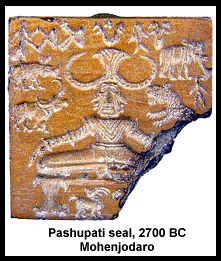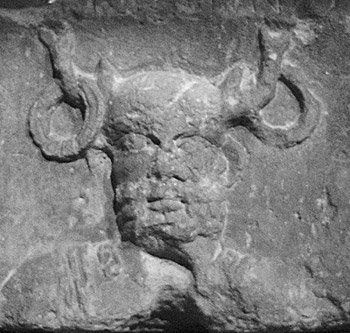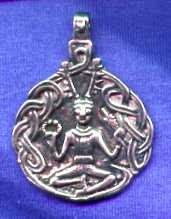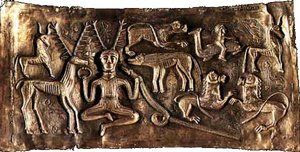Shiva is the most ancient God of India and he was called Pashu Pati also. The "wine, meat and sex" part of Tantra goes to the revelry in the earliest days of the world religion(s). He is often associated with snakes, bull and other animals.
Dionysus is the Greek equivalent of Shiva (sometimes equated with Balraam as Herculues is equated with Krishna) and Geeks acknowledge that this God of theirs came from India. (Source Anacalypsisand many other books).
Wriiten here in this book Ref 1 is:
Although the political prominence of Vishnu and Shiva belong to the Age of reformed Brahmanism, it is undoubted that both deities were worshipped throughout the long period of Buddhistic ascendancy. The Greek ambassador Megasthenes, who resided in India between B.C. 311 and 302, and wrote Ta Indika, furnishes interesting evidence in this connection. "By his description of the god Dionysus, whom they worshipped in the mountains, Shiva", says Professor Macdonell, "must be intended, and by Herakles, adored in the plains . . . no other can be meant than Vishnu and his incarnation Krishna. . . . These statements seem to justify the conclusion that Shiva and Vishnu were already prominent as highest gods, the former in the mountains, the latter in the Ganges valley. . . . We also learn from Megasthenes that the doctrine of the four Ages of the World (Yugas) was fully developed in India by this time."
Here in Ref 2 it says:
By far the most generally accepted and most significant of the animal embodiments of the god, however, was that of a bull. There were a multitude of cult appellatives emphasizing this conception of Dionysus. He was variously addressed as the "horned child," the "horned deity," the "bull-horned," and the "bull-browed." The Argives worshiped him as "the son of a cow" or "bull-born," and the ancient Elean chant addressed him directly as a bull. "Come, hero Dionysus, come with the Graces to thy house by the shores of the sea; hasten with thy bull-foot." So ran the hymn itself, while the chorus repeated "goodly bull, goodly bull." One readily recalls, also, that the residence of the king-archon at Athens, where the sacred marriage between Dionysus and the basilinna was celebrated, was called the boukolion, or "ox stall."
Appear, appear, whatso thy shape or name
O Mountain Bull, Snake of the Hundred Heads, (Shesh Naag)
Then a God bull-horned Zeus bare, And with serpents entwined his hair.
They are crowned with snakes
They dressed themselves in fawnskins and wound snakes around
Here in Ref. 3 it is says:
It may reasonably be assumed, therefore, that the Roman ceremonies were not essentially different from their Asian originals.
Remember this wass written when Paganism was taken derogatively and negatively.

Pashupati in Indus Valley

Pashupati in Indus Valley

Irish Pashupati or Shiva - Cernunnos. Notice the snake which is often found associated with Shiva and not found in Europe as far as I know.

http://en.wikipedia.org/wiki/Cernunnos


Celtic Lord of Beast - Pashupati

From Image Carving on Gundestrup Cauldron found in Denmark
From Image Carving on Gundestrup Cauldron found in Denmark
Banteay Srei: Oldest Hindu Temple In Cambodia
.Update: The Gundestrup cauldron Plate B has a supposedly picture of Lakshmi with two Elephants.
Anecdotal: I had a Yoga Student who went to stay in Denmark for 2-3 years. I used to tell her about my findings and she would be skeptical about what I would say, until she went to local museums there and found many Indian artifacts. She also talked to local folks, and they said that their ancestors had come from India. Discovery Channel also had reported finding Buddha statutes in a ship wreck site. All this is again connected with the Proto Indo European People, Language, Religion and Culture, which the West likes to call, and is based on DNA, Linguistics and Archeological studies.



1 comment:
In Vaidic system, which is associated with Aryans, primarily, there is Aadishakti[you may call it as pure energy]. This is combination of both male and female energy. This pure energy manifested as "Mahakali, Mahalakshmi,Mahasaraswati" & "Bramha, Vishnu, Mahesh". ThisMahesh is referred asRudra or Shiva.
Primarily, there were two systems of worship: Shaiva and Vaishnav.
Shaiva combines Shiva,Sati, Parvati, Nandi, Murugan, Kartikeya, Ganesh, Hanuman, Balaram......
Now, in India, Primarily, there are five Main Gods/systems of worship: Shaiva, Vaishnav, Bramha, Ganesh and Shakti.
Post a Comment